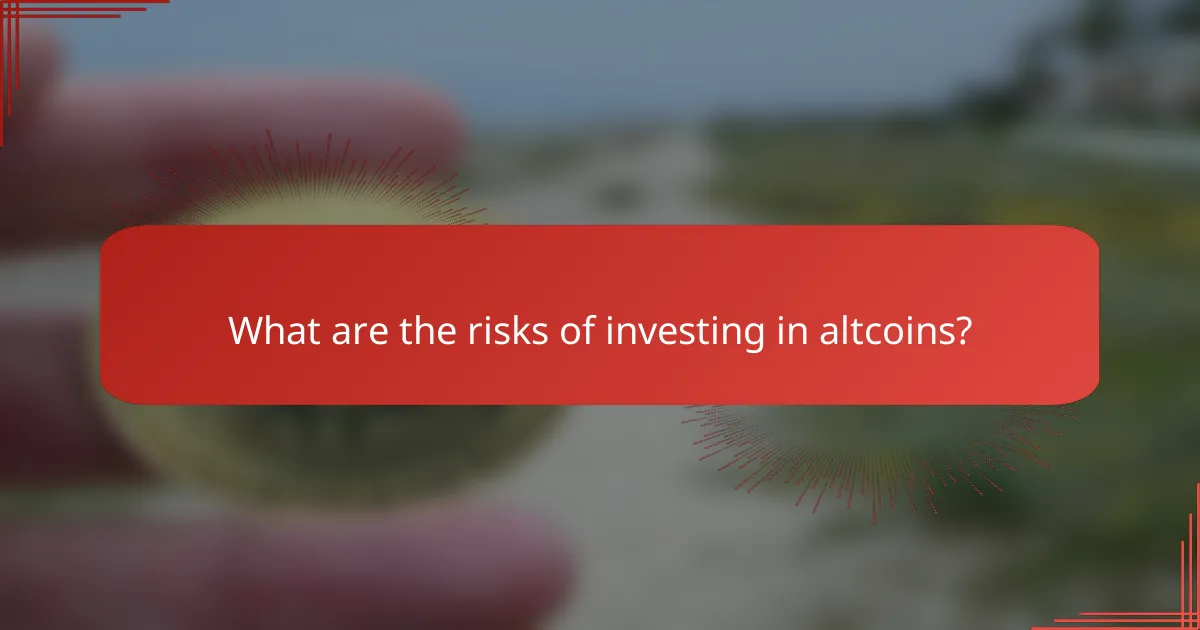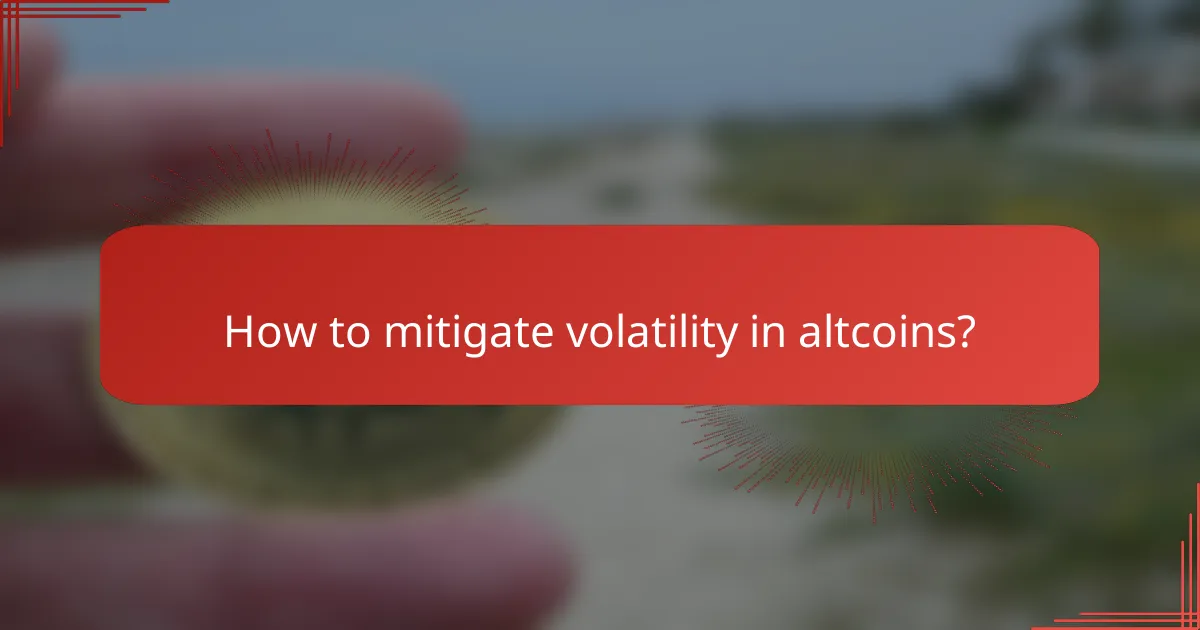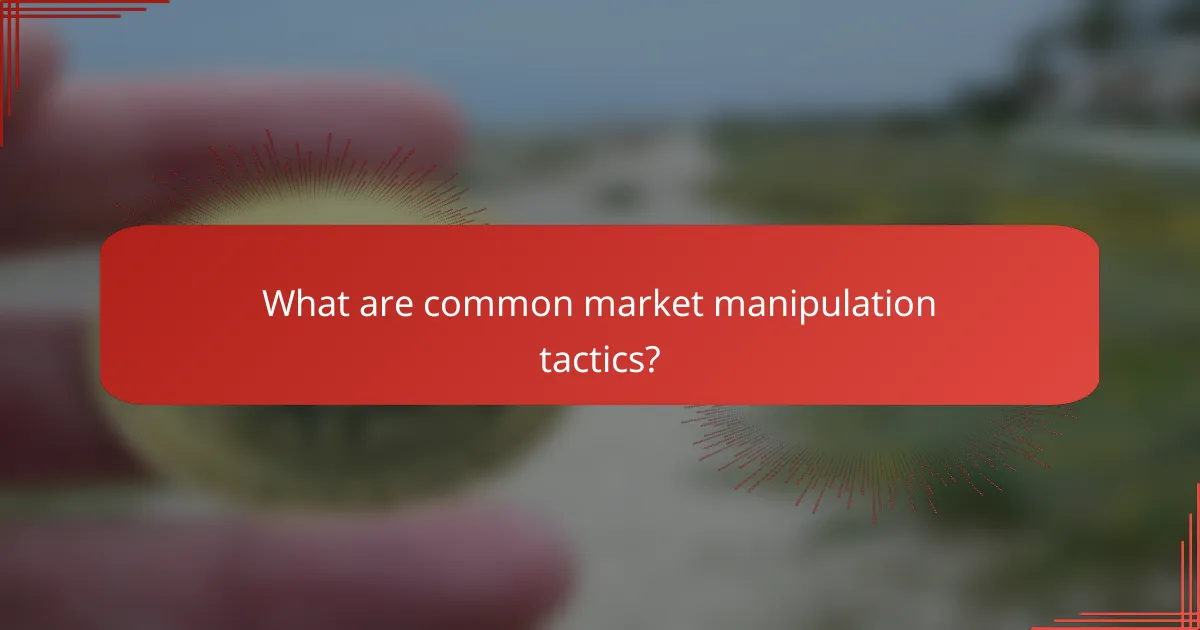Investing in altcoins presents unique challenges, including significant price volatility, evolving regulatory landscapes, security vulnerabilities, and the risk of market manipulation. A thorough understanding of these risks is essential for investors seeking to navigate the complexities of the altcoin market effectively.

What are the risks of investing in altcoins?
Investing in altcoins carries several risks, including price volatility, regulatory uncertainties, security issues, and potential market manipulation. Understanding these risks is crucial for making informed investment decisions in the altcoin market.
Volatility in altcoin prices
Altcoin prices are known for their extreme volatility, often experiencing significant fluctuations within short periods. This can lead to substantial gains but also steep losses, making it essential for investors to be prepared for rapid changes in value.
To manage volatility, consider setting stop-loss orders to limit potential losses and diversifying your portfolio to spread risk across different assets. Monitoring market trends and news can also help anticipate price movements.
Regulatory challenges for altcoins
Regulatory challenges pose a significant risk to altcoin investments, as governments worldwide are still developing frameworks to govern cryptocurrencies. Changes in regulations can impact the legality and usability of certain altcoins, affecting their value.
Investors should stay informed about local regulations and potential government actions that could influence the altcoin market. Engaging with reputable exchanges and projects that comply with regulations can also mitigate some of these risks.
Security vulnerabilities in altcoin wallets
Security vulnerabilities in altcoin wallets can lead to the loss of funds through hacks or scams. Unlike traditional banking systems, the cryptocurrency space lacks robust consumer protections, making it crucial to choose secure wallet options.
Use hardware wallets for long-term storage and enable two-factor authentication on exchanges. Regularly updating wallet software and being cautious of phishing attempts can further enhance security.
Market manipulation tactics in altcoin trading
Market manipulation tactics, such as pump-and-dump schemes, are prevalent in the altcoin market due to its relatively low liquidity. These tactics can artificially inflate prices, leading unsuspecting investors to buy in before a sudden drop occurs.
To avoid falling victim to manipulation, conduct thorough research on altcoins before investing and be wary of hype-driven promotions. Following credible sources and engaging with established communities can help identify legitimate projects and avoid scams.

How to mitigate volatility in altcoins?
To mitigate volatility in altcoins, investors can adopt various strategies that help stabilize their investments. These methods include diversification, using stop-loss orders, and investing in stablecoins, each addressing different aspects of market fluctuations.
Diversification strategies
Diversification involves spreading investments across different altcoins and asset classes to reduce risk. By holding a mix of cryptocurrencies, investors can buffer against the price swings of any single coin. For example, instead of investing solely in one altcoin, consider allocating funds to several top performers and emerging projects.
A common approach is to maintain a balanced portfolio, where no single asset exceeds a certain percentage of the total investment, often around 10-20%. This way, if one coin experiences significant volatility, the overall impact on the portfolio is minimized.
Using stop-loss orders
Stop-loss orders are a practical tool for limiting potential losses in volatile markets. By setting a stop-loss order at a predetermined price point, investors can automatically sell their altcoins if the price drops below that level. This helps to prevent further losses during sharp declines.
When implementing stop-loss orders, consider placing them at levels that reflect your risk tolerance, typically 5-15% below the purchase price. However, be cautious of setting them too close to the market price, as minor fluctuations could trigger unnecessary sales.
Investing in stablecoins
Investing in stablecoins can provide a safe haven during periods of high volatility in the altcoin market. Stablecoins are pegged to stable assets, such as the US dollar, which helps maintain their value. This allows investors to hold their assets in a less volatile form while still participating in the cryptocurrency market.
For example, converting a portion of your altcoin holdings into stablecoins like USDT or USDC can protect your investment from sudden market downturns. This strategy is particularly useful during uncertain market conditions, allowing for quick re-entry into altcoins when prices stabilize.

What regulations affect altcoin investments?
Altcoin investments are influenced by various regulations that aim to protect investors and maintain market integrity. These regulations can vary significantly by country, affecting how altcoins are classified and traded.
SEC guidelines on altcoins
The U.S. Securities and Exchange Commission (SEC) has established guidelines that classify many altcoins as securities. This classification means that they must comply with federal securities laws, which include registration requirements and disclosure obligations.
Investors should be aware that the SEC often evaluates whether an altcoin is a security based on the Howey Test, which assesses whether an investment involves an expectation of profits derived from the efforts of others. Non-compliance can lead to legal repercussions for both issuers and investors.
International regulatory frameworks
Globally, altcoin regulations vary widely. In the European Union, for instance, the Markets in Crypto-Assets (MiCA) regulation aims to create a comprehensive framework for crypto assets, including altcoins, to enhance investor protection and market stability.
In contrast, countries like China have imposed strict bans on cryptocurrency trading and Initial Coin Offerings (ICOs). Investors should research the regulatory environment in their respective countries to ensure compliance and understand the risks associated with altcoin investments.

How to enhance security when trading altcoins?
Enhancing security when trading altcoins involves implementing protective measures to safeguard your assets from theft and fraud. Key strategies include using hardware wallets and enabling two-factor authentication to add layers of security to your trading activities.
Using hardware wallets
Hardware wallets are physical devices that securely store your private keys offline, significantly reducing the risk of hacking. They are considered one of the safest options for managing cryptocurrencies, as they keep your assets away from online threats.
When choosing a hardware wallet, consider reputable brands like Ledger or Trezor, which offer user-friendly interfaces and strong security features. Always purchase directly from the manufacturer to avoid counterfeit devices.
Two-factor authentication
Two-factor authentication (2FA) adds an extra layer of security by requiring a second form of verification, such as a code sent to your mobile device, in addition to your password. This makes it much harder for unauthorized users to access your trading accounts.
To implement 2FA, enable it on all exchanges and wallets that support it. Use authentication apps like Google Authenticator or Authy for added security, rather than relying solely on SMS, which can be vulnerable to interception.

What are common market manipulation tactics?
Common market manipulation tactics involve deceptive practices that artificially influence the price of altcoins. These tactics can mislead investors, resulting in significant financial losses and market instability.
Pump and dump schemes
Pump and dump schemes occur when a group of individuals artificially inflate the price of an altcoin through misleading promotions. Once the price rises significantly, they sell off their holdings at the peak, leaving other investors with losses as the price plummets.
Investors should be cautious of sudden price spikes accompanied by hype on social media or online forums. A common sign of a pump and dump is a sharp increase in trading volume without any fundamental news to support it.
To protect yourself, conduct thorough research before investing and be wary of altcoins that seem to have no legitimate use case or development backing.
Wash trading practices
Wash trading involves a trader buying and selling the same altcoin simultaneously to create misleading activity in the market. This tactic can give the illusion of high demand and liquidity, prompting unsuspecting investors to enter the market.
Recognizing wash trading can be difficult, but signs include a consistent pattern of trades between the same wallets or exchanges. This practice is often used to manipulate prices and can lead to significant losses for those who invest based on false signals.
To avoid falling victim to wash trading, scrutinize trading volumes and patterns, and consider using reputable exchanges that monitor for such activities.

What criteria should you consider when choosing altcoins?
When selecting altcoins, consider factors such as market capitalization, project fundamentals, regulatory environment, and security measures. These criteria can help you assess the potential risks and rewards associated with different altcoins.
Market capitalization
Market capitalization is a key indicator of an altcoin’s size and stability. It is calculated by multiplying the current price of the coin by its total circulating supply. Generally, larger market caps suggest greater stability, while smaller caps may indicate higher volatility.
For example, altcoins with market capitalizations in the low millions may experience significant price swings, whereas those in the hundreds of millions or billions tend to have more predictable price movements. A common heuristic is to consider investing in altcoins with market caps above $100 million for a better balance of risk and reward.
Always compare the market cap of an altcoin with its trading volume and historical performance to gauge its liquidity and investor interest. Avoid coins with very low market caps and trading volumes, as they can be more susceptible to manipulation and sudden price drops.


